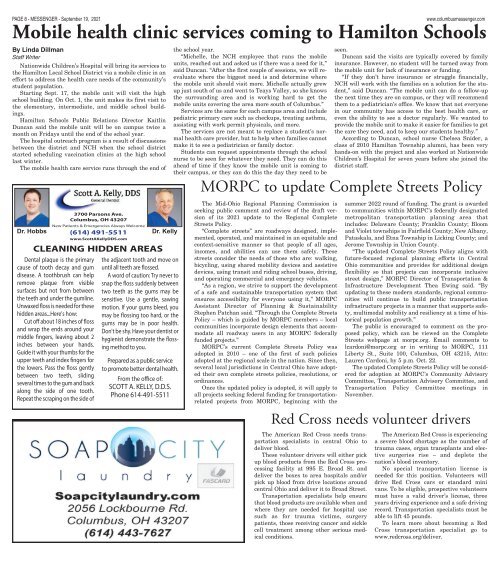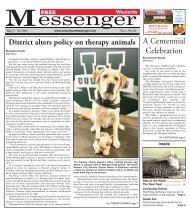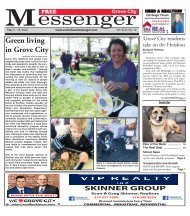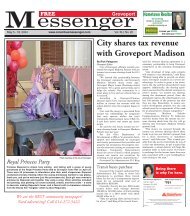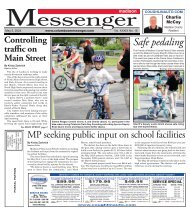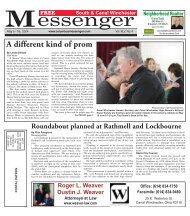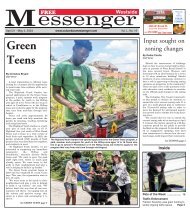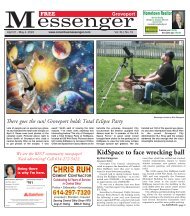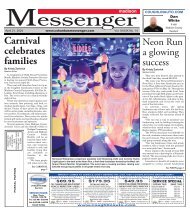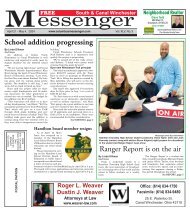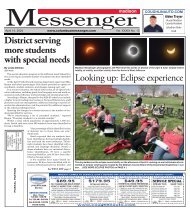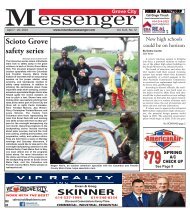South Messenger - September 19th, 2021
Create successful ePaper yourself
Turn your PDF publications into a flip-book with our unique Google optimized e-Paper software.
www.columbusmessenger.com<br />
Mobile health clinic services coming to Hamilton Schools<br />
PAGE 8 - MESSENGER - <strong>September</strong> 19, <strong>2021</strong><br />
By Linda Dillman<br />
Staff Writer<br />
Nationwide Children’s Hospital will bring its services to<br />
the Hamilton Local School District via a mobile clinic in an<br />
effort to address the health care needs of the community’s<br />
student population.<br />
Starting Sept. 17, the mobile unit will visit the high<br />
school building. On Oct. 1, the unit makes its first visit to<br />
the elementary, intermediate, and middle school buildings.<br />
Hamilton Schools Public Relations Director Kaitlin<br />
Duncan said the mobile unit will be on campus twice a<br />
month on Fridays until the end of the school year.<br />
The hospital outreach program is a result of discussions<br />
between the district and NCH when the school district<br />
started scheduling vaccination clinics at the high school<br />
last winter.<br />
The mobile health care service runs through the end of<br />
Dr. Hobbs<br />
3700 Parsons Ave.<br />
Columbus, OH 43207<br />
New Patients & Emergencies Always Welcome<br />
(614) 491-5511<br />
www.ScottAKellyDDS.com<br />
CLEANING HIDDEN AREAS<br />
Dental plaque is the primary<br />
cause of tooth decay and gum<br />
disease. A toothbrush can help<br />
remove plaque from visible<br />
surfaces but not from between<br />
the teeth and under the gumline.<br />
Unwaxed floss is needed for these<br />
hidden areas...Here's how:<br />
Cut off about 18 inches of floss<br />
and wrap the ends around your<br />
middle fingers, leaving about 2<br />
inches between your hands.<br />
Guide it with your thumbs for the<br />
upper teeth and index fingers for<br />
the lowers. Pass the floss gently<br />
between two teeth, sliding<br />
several times to the gum and back<br />
along the side of one tooth.<br />
Repeat the scraping on the side of<br />
Dr. Kelly<br />
the adjacent tooth and move on<br />
until all teeth are flossed.<br />
A word of caution: Try never to<br />
snap the floss suddenly between<br />
two teeth as the gums may be<br />
sensitive. Use a gentle, sawing<br />
motion. If your gums bleed, you<br />
may be flossing too hard, or the<br />
gums may be in poor health.<br />
Don't be shy. Have your dentist or<br />
hygienist demonstrate the flossing<br />
method to you.<br />
Prepared as a public service<br />
to promote better dental health.<br />
From the office of:<br />
SCOTT A. KELLY, D.D.S.<br />
Phone 614-491-5511<br />
the school year.<br />
“Michelle, the NCH employee that runs the mobile<br />
units, reached out and asked us if there was a need for it,”<br />
said Duncan. “After the first couple of sessions, we will reevaluate<br />
where the biggest need is and determine where<br />
the mobile unit should visit more. Michelle actually grew<br />
up just south of us and went to Teays Valley, so she knows<br />
the surrounding area and is working hard to get the<br />
mobile units covering the area more south of Columbus.”<br />
Services are the same for each campus area and include<br />
pediatric primary care such as checkups, treating asthma,<br />
assisting with work permit physicals, and more.<br />
The services are not meant to replace a student’s normal<br />
health care provider, but to help when families cannot<br />
make it to see a pediatrician or family doctor.<br />
Students can request appointments through the school<br />
nurse to be seen for whatever they need. They can do this<br />
ahead of time if they know the mobile unit is coming to<br />
their campus, or they can do this the day they need to be<br />
The Mid-Ohio Regional Planning Commission is<br />
seeking public comment and review of the draft version<br />
of its <strong>2021</strong> update to the Regional Complete<br />
Streets Policy.<br />
“Complete streets” are roadways designed, implemented,<br />
operated, and maintained in an equitable and<br />
context-sensitive manner so that people of all ages,<br />
incomes, and abilities can use them safely. These<br />
streets consider the needs of those who are: walking,<br />
bicycling, using shared mobility devices and assistive<br />
devices, using transit and riding school buses, driving,<br />
and operating commercial and emergency vehicles.<br />
“As a region, we strive to support the development<br />
of a safe and sustainable transportation system that<br />
ensures accessibility for everyone using it,” MORPC<br />
Assistant Director of Planning & Sustainability<br />
Stephen Patchan said. “Through the Complete Streets<br />
Policy — which is guided by MORPC members — local<br />
communities incorporate design elements that accommodate<br />
all roadway users in any MORPC federally<br />
funded projects.”<br />
MORPC’s current Complete Streets Policy was<br />
adopted in 2010 — one of the first of such policies<br />
adopted at the regional scale in the nation. Since then,<br />
several local jurisdictions in Central Ohio have adopted<br />
their own complete streets policies, resolutions, or<br />
ordinances.<br />
Once the updated policy is adopted, it will apply to<br />
all projects seeking federal funding for transportationrelated<br />
projects from MORPC, beginning with the<br />
seen.<br />
Duncan said the visits are typically covered by family<br />
insurance. However, no student will be turned away from<br />
the mobile unit for lack of insurance or funding.<br />
“If they don’t have insurance or struggle financially,<br />
NCH will work with the families on a solution for the student,”<br />
said Duncan. “The mobile unit can do a follow-up<br />
the next time they are on campus, or they will recommend<br />
them to a pediatrician’s office. We know that not everyone<br />
in our community has access to the best health care, or<br />
even the ability to see a doctor regularly. We wanted to<br />
provide the mobile unit to make it easier for families to get<br />
the care they need, and to keep our students healthy.”<br />
According to Duncan, school nurse Chelsea Snider, a<br />
class of 2010 Hamilton Township alumni, has been very<br />
hands-on with the project and also worked at Nationwide<br />
Children’s Hospital for seven years before she joined the<br />
district staff.<br />
MORPC to update Complete Streets Policy<br />
summer 2022 round of funding. The grant is awarded<br />
to communities within MORPC’s federally designated<br />
metropolitan transportation planning area that<br />
includes: Delaware County; Franklin County; Bloom<br />
and Violet townships in Fairfield County; New Albany,<br />
Pataskala, and Etna Township in Licking County; and<br />
Jerome Township in Union County.<br />
“The updated Complete Streets Policy aligns with<br />
future-focused regional planning efforts in Central<br />
Ohio communities and provides for additional design<br />
flexibility so that projects can incorporate inclusive<br />
street design,” MORPC Director of Transportation &<br />
Infrastructure Development Thea Ewing said. “By<br />
updating to these modern standards, regional communities<br />
will continue to build public transportation<br />
infrastructure projects in a manner that supports safety,<br />
multimodal mobility and resiliency at a time of historical<br />
population growth.”<br />
The public is encouraged to comment on the proposed<br />
policy, which can be viewed on the Complete<br />
Streets webpage at morpc.org. Email comments to<br />
lcardoni@morpc.org or in writing to MORPC, 111<br />
Liberty St., Suite 100, Columbus, OH 43215, Attn:<br />
Lauren Cardoni, by 5 p.m. Oct. 22.<br />
The updated Complete Streets Policy will be considered<br />
for adoption at MORPC’s Community Advisory<br />
Committee, Transportation Advisory Committee, and<br />
Transportation Policy Committee meetings in<br />
November.<br />
Red Cross needs volunteer drivers<br />
The American Red Cross needs transportation<br />
specialists in central Ohio to<br />
deliver blood.<br />
These volunteer drivers will either pick<br />
up blood products from the Red Cross processing<br />
facility at 995 E. Broad St. and<br />
deliver the boxes to area hospitals and/or<br />
pick up blood from drive locations around<br />
central Ohio and deliver it to Broad Street.<br />
Transportation specialists help ensure<br />
that blood products are available when and<br />
where they are needed for hospital use<br />
such as for trauma victims, surgery<br />
patients, those receiving cancer and sickle<br />
cell treatment among other serious medical<br />
conditions.<br />
The American Red Cross is experiencing<br />
a severe blood shortage as the number of<br />
trauma cases, organ transplants and elective<br />
surgeries rise — and deplete the<br />
nation’s blood inventory.<br />
No special transportation license is<br />
needed for this position. Volunteers will<br />
drive Red Cross cars or standard mini<br />
vans. To be eligible, prospective volunteers<br />
must have a valid driver’s license, three<br />
years driving experience and a safe driving<br />
record. Transportation specialists must be<br />
able to lift 45 pounds.<br />
To learn more about becoming a Red<br />
Cross transportation specialist go to<br />
www.redcross.org/deliver.


